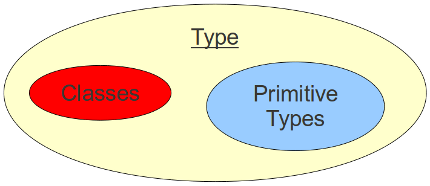CSC/ECE 517 Fall 2010/ch3 4b mt
Types vs Classes

Introduction
It is often that we talk about types, strongly typed, weakly typed, classes. To make it clear, let us look into it clearly. Every programming language has a way to define a variable. A variable is a named address location which stores a particular value.
Types
Time for an analogy? Imagine a variable to be a vacant house. It could have animals, humans, robots, or another smaller house, or whatever you can think of. There has to be a way, from a third party perspective, so as to be cognizant of the kind of things that reside in the house. Types and typing is a concept which realizes this concept. A typed language or a strongly typed language is one where the type of a variable has to be declared so as to avoid any wrong dealings of the value during run time. For example, Java is a strongly typed language. If I need to use 2 integers for addition, I would explicitly have to mention them as an integer:-
int integer1;
int integer2;
However, we can’t do a character initialization in the course of a program.
integer1 = “Hello World”;
Is however, not allowed.
whereas, in case of non-typed languages, say Ruby, or Visual Basic etc. for example, we don’t need to specify a type.
def variable1;
def variable2;
Now, it could be initialized with anything,
variable1 = 3
as well as
variable1 = “Good morning Vietnam” are allowed.
Classes
A class is a “type” of variable specification. The difference between a class and a regular primitive integer, character etc is that a class is:-
- A class consists of one or more primitive or non-primitive variables
- It is a pre defined structure
The Type of Class is “Class”, just like the Type of integer1 is “integer” in case of strongly typed languages.
For example, in case of Java:-
“The types of the Java programming language are divided into two categories: primitive types and reference types. The primitive types are the boolean type and the numeric types. The numeric types are the integral types byte, short, int, long, and char, and the floating-point types float and double. The reference types are class types, interface types, and array types. There is also a special null type. An object is a dynamically created instance of a class type or a dynamically created array. The values of a reference type are references to objects. All objects, including arrays, support the methods of class Object . String literals are represented by String objects .” [2]
So, as mentioned before, in Java, there are two “Types”:-
i)Primitive Type ii)Reference Type :- Classes, Interfaces, Arrays are all consolidations of Primitive types, so they just need to “point” to or reference the primitive ones, hence the name.
Types and Classes in Languages
Ruby
Ruby claims to be a strong object oriented language. It is object oriented to the extent that every thing is an object. Primitive datatypes are objects, and we can make use of the object oriented techniques on even the primitives. As mentioned before, Ruby is a dynamic typed language, as the type is bound at compile time. Everything in Ruby has a class. Every class in Ruby is inherited from class Class.
Type in Ruby is well defined as well. Using self inspection (reflection), we can find out whether a name is a Class, or a method. Let us see this in action:-
The first thing that comes to a one’s mind is something like :
5.class #=> Fixnum
"hello".class #=> String
But have you thought of your class as an object? Well that seems odd, but that’s how ruby works:
5.class #=> Fixnum
class Foo;end #=> nil
Foo.class #=> Class
What does the above snippet of code mean exactly? It means 2 things : Foo is a constant and that constant holds(refers to) an object of Class type.
Let us prove that:
Foo = Class.new
(irb):8 warning: already initialized constant Foo
=> Foo
As you can see, we got a warning because we tried to initialize the constant Foo again.
So ,when you define some class ‘Foo’ in ruby, all you are doing is: 1-instantiating an object of type Class. 2-initializing a constant Foo that refers to that created object .
So, when we say “object” ,then we do mean any object; an object of Class type, or any object of any type.[3]
Java
As mentioned before, Java is a strongly typed language. The type of data needs to be declared before using. The types of "types" in Java are :
* Primitive Types:- boolean and numeric. The numeric types are the integral types byte, short, int, long, and char, and the
floating-point types float and double.
* Reference Types:- class types, interface types and array types. [2]
Java is an object-oriented language, but it does make a clear distinction between the primitive type and Classes. int, float, char etc. are primitives, and the other data types other than the primitives are references. It is an interesting distinction to note, because of the differences in method calling system in different languages. Java makes a distinction in "calling-by-value" when a primitive is passed as a parameter, and "calling-by-reference" when an object is passed. This can be shown
References
[1] http://download.oracle.com/javase/tutorial/java/nutsandbolts/datatypes.html
[2] Java:- Types, Values and Variables
http://java.sun.com/docs/books/jls/third_edition/html/typesValues.html
[3] Ruby Reflection ,http://www.khelll.com/blog/ruby/ruby-reflection/